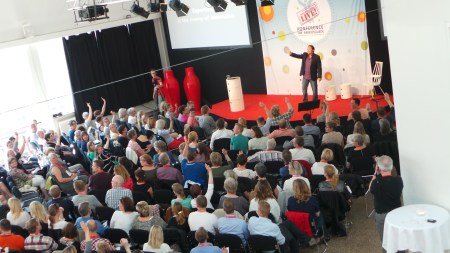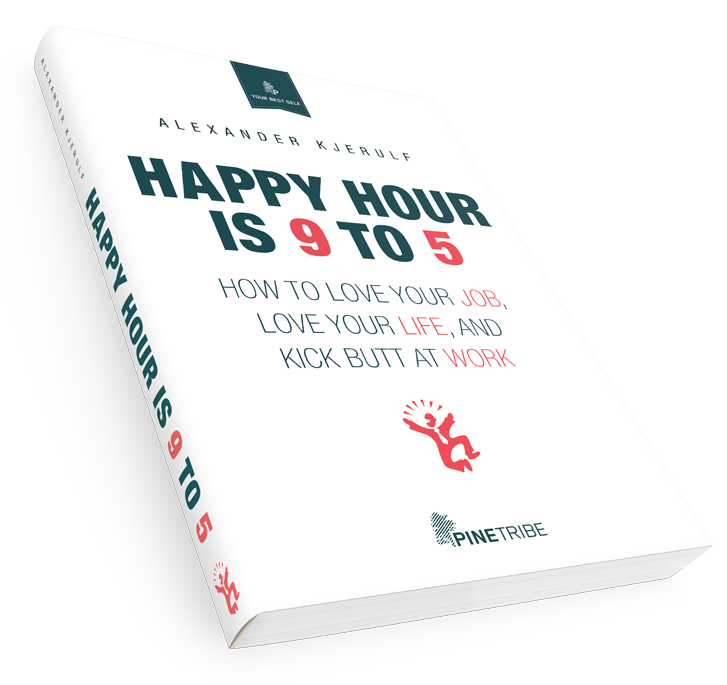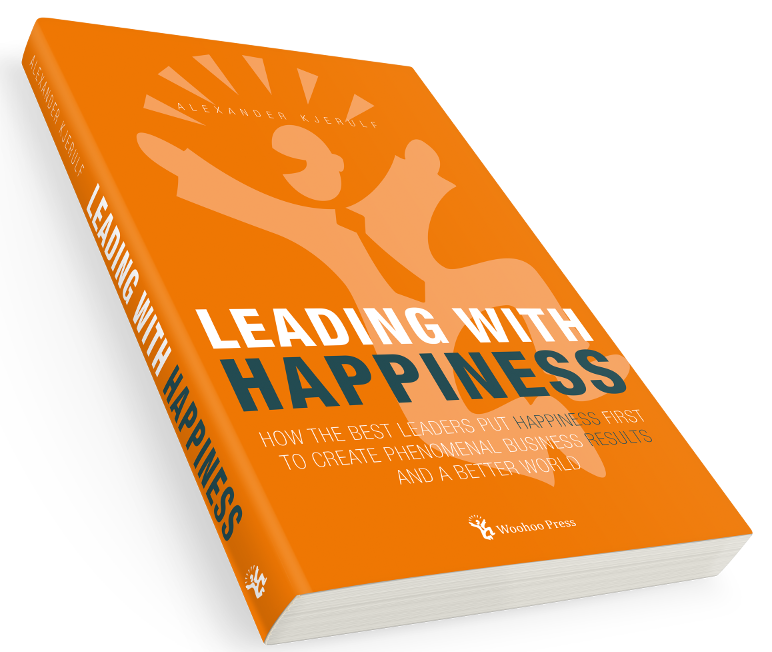-
Two Danish bosses surprise their employees in the morning
Carsten and Karsten, two sales managers at Danish company Solar, wanted to do something nice for their employees.
Early one Monday morning, they stood at the entrance and greeted every employee with a cheerful “good morning” and a breakfast they could take to their desks.
This a great example of a “random act of workplace kindness”. Have you ever done something surprising and nice for a co-worker? Let us know in a comment.
-
5 ways to boost your career with happiness
In this hilarious and insightful speech, Rowan Manahan explains that happiness at work (in Danish: arbejdsglaede) is not a pipe dream but the best way to get your dream job, boost your career and become more successful.
Why don’t people pay a little more attention (and a whole lot more respect!) to their own happiness — and what happens when they do?
Rowan argues that this is the next evolutionary leap that mankind will make and has some simple, practical, and actionable steps that you can take to come out of the Dark Ages in your working life and into the Age of Enlightenment.
The speech is from our Arbejdsglaede Live! 2013 conference, held annually in Copenhagen Denmark in May.
About Rowan Manahan:
Rowan Manahan is the author of the best-seller, Where’s My Oasis? (The Essential Handbook for Everyone Wanting That Perfect Job) and Ultimate CV (Trade Secrets from a Recruitment Insider). He serves as an External Lecturer for Trinity College Dublin, Bochum University, the National College of Ireland, Dublin Institute of Technology, and Froebel College of Education. He is a frequent conference speaker and appears regularly in the media sharing his expertise and advice.Rowan loves good minds, great music, chop-sockey videos and smelly cheese. He variously describes himself as an author, insultant, storyteller, TEDx curator, husband, father, and dancing bear.
His Mantra is: “We are 98.5% chimpanzee, 1.5% civilized human being.”
-
Thank you, Chile!

I’m back in Copenhagen after my week in Chile where I spoke at two really great events – one of them for 1,000 participants, the other for executives from construction companies. Both events went really, really well.
The trip was amazing and my hosts from Caja Los Andes and Business Bureau were both very organised and incredibly nice :o)
A great big thank you to everyone who came to the events – you were awesome! I hope to come back to Chile soon.
Here are a few of my favorite pics from the trip.
-
I’m off to speak in Chile
OK, my bags are packed and I’m headed to the airport. I have two speeches in Santiago, Chile on June 26 and 27 and that will officially make it 30 countries we’ve spoken in. That is a major, major milestone.
-
Meet The PortaBoss

Meet Pawel, the CEO of IT company Lunar Logic in Poland. Unlike most CEOs he doesn’t have a fancy corner office. In fact, he has NO office. Here’s how it works:
A laptop desk, a bean bag and a recycled cardboard box – that’s all he needs to set up a flying office. He can usually be found in a few rooms in our office, shifting his spot couple of times a day. Or a week. The pattern changes. Not only because of a possible back pain – there are several reasons for him being in motion. Some of which have already changed our company.
I think it’s a great experiment. Does it work? Here’s what Pawel says:
I can grab my flying office in my hands and move it to the place where I’m needed or I feel like I can be helpful. I need just a bit of space in a corner or by the wall and done – a new office set up.
Surprisingly, sitting in the corner and almost on the floor has a few unexpected advantages . First, you need very little physical space, which means you will fit to almost any room (unless it is already packed beyond any healthy limits). Second, this way you become almost invisible, which definitely helps if your goal is to understand how the team functions, and not just scratch the surface.
Third, and arguably most importantly, you strip yourself from status symbols. Instead of a huge desk dubbed by your colleagues as the airstrip, a leather armchair and a locker just the simplest set that does the job.
All in all, you’re way more accessible and much less intimidating. Isn’t that something every single leader should strive for?
Read all about it here to find out what his employees honestly think about it.
-
Our conference about happiness at work was a massive hit

On May 30 we held our 5th annual conference about happiness at work in Copenhagen and this one was the best one yet :-)
The event was completely sold out and 360 participants saw 11 different speakers share their ideas and tips about creating happy workplaces. The feedback has been stunningly positive – 80% give the day a top grade and 18% give it 4 out of 5.
As always we filmed all the speakers and will put them online for free. You can see the first speech here – it’s an insanely inspiring talk where David Marquet explains how he made a nuclear submarine a happy workplace.
You can see some pictures from the event below and there are a ton more pics here, courtesy of our fantastic photographer Gareth Garvey.
-
How to scare a stewardess
When I give speeches about happiness at work, I often mention Southwest Airlines and how their cabin attendants make sure to have fun at work. One story I often share is how they’ll sometimes hide a shorter crew member in the overhead compartment and give one lucky passenger a little surprise
Well, I guess turnabout is fair play:
I’d say she was surprised :o)
Here’s an example with the flight attendant hidden in the overhead compartment:
-
Want better work-life balance? Learn from Denmark!
3 of my fellow Danes, Camilla Kring, Vivi Bach Pedersen and Anders Raastrup Kristensen have written a report on how Danish businesses have become more productive by focusing on work-life balance.
This is how they open the report:
The future can be found in Denmark. In this report we show how some of the most successful companies in Denmark developed their business through an innovative, results-oriented focus on balancing employees’ work and private lives.
- Denmark has a unique position in the world when it comes to balancing work and private life:
- Denmark has one of the highest participation rates for women in the workforce. (75% of women are in the workforce).
- Among all EU countries, Danish employees have the highest degree of influence over their work.
- (85% of employees indicate that they have an influence on their work situation).
- Danish employees have some of the world’s most flexible work conditions. (43% of employees can regulate their work hours to meet their private needs).
- Danish employees have some of the best maternity/paternity leaves in the world (combined one year leave per child).
The crucial insight in the report is that work-life balance is not about sacrificing business goals for the employees’ well-being. In fact, a good work-life balance makes the company more successful and profitable.
Read the whole report here – it’s clearly very written and has many tips and ideas for workplaces all over the world who want to create a
-
Check out our new-and-improved YouTube channel
We’ve recently updated and redesigned our YouTube channel and we’d love to know what you think.
Take a look at it – any feedback will be much appreciated.
-
I quit my unhappy job too late

I got an awesome email from a reader of the blog, who found the courage to quit a well-paying job and move on to something else. Here’s his story:
I was very unhappy in my last job, and though I knew your work, I still quit too late. I feel like I should have quit half a year ago.
So, why did I stay too long in the old job?
There were two reasons: One was money. Not the amount they pay, but rather the security that it gave me. I had no savings but was in debt. Which scared me about changing my job. If the new job wouldn’t have been good, I would have had a problem. This is now different, when I finally applied I had enough savings to live for some months without a job.
The second reason was the memory of the good times in this company. It really started out nice. Most people there are really likeable. The problems started when a coworker quit and I got his position. This position is really shitty, because of bad management and a lot of organizational problems. Of course, I knew part of this beforehand and I made it a condition that these things change. My boss agreed to this, because otherwise I would have refused to take the position. But in nearly a year, next to nothing changed. Of course, a lot of things changed. But not the really important stuff. For a long time I thought they will change, I worked for them to change. I just wished to be as happy as in the beginning.
Over time, I developed most of your warning signs. (Physical symptoms, procrastination, I stopped to care, …) The unhappiness made me even more unhappy.
When I’m happy, I’m motivated and do my work well. When I started to grow unhappy, I saw that my work isn’t as half as good as it could be. And I even need more time to do it, because I didn’t want to do it in the first place. Knowing I do not nearly as good as I could increased the unhappiness and decreased motivation further. So it grew worse over time, with no way out. I even tried to get rid of this work, to get new assignments. But nobody else at the company had the necessary knowledge, so my boss wouldn’t let me change it, despite knowing that I am not happy with it.
At my new workplace, the manager talks about motivation and job satisfaction/happiness. (The German word used is Zufriedenheit, which can be translated both ways).
There is also a culture of respect. The managemant demands that people work together for a common goal, which is also very nice. All the people I know so far are nice and welcoming. I only work for two days at my new job, but I’m already confident that this will be a nice place to work.
I wrote this down, in case you want to use it for any future article. If you use it, please substitute my name with a pseudonym.
Kudos on finding the courage to quit an unhappy job and move on to something better!
Related posts
Connect
Get our newsletter
“I can’t believe it – a newsletter actually worth reading!”
– Subscriber
Over 6,000 people subscribe to our newsletter with tons of tips about happiness at work.
Get our books

“It’s very, very good. It’s incredibly well written, full of insights, and there are exercises to improve your own happiness at work. You can’t ask for more than that!”
– David Maister, author of Practice What You Preach

“What an inspiring book. Every leader should read it. This type of leadership has been integral to our success and I know it will boost your results too.“
– Garry Ridge, CEO WD-40 Company
Get Our Free Newsletter
Over 6,000 people already get our free newsletter with useful tips, videos, links and articles about happiness at work.
Subscribe to our newsletter here.



















